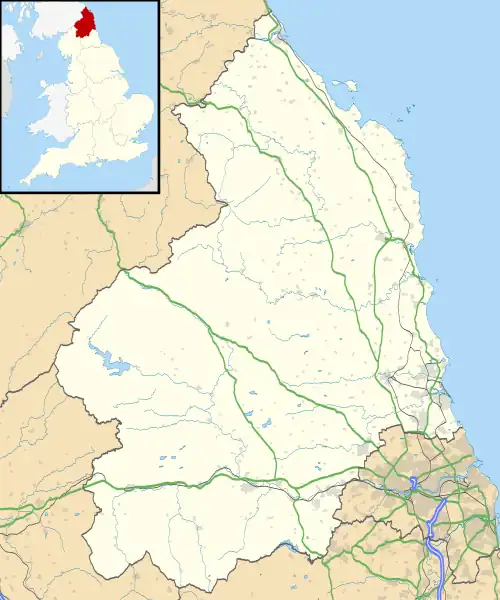| Site of Special Scientific Interest | |
 Location within Northumberland | |
| Location | Northumberland |
|---|---|
| Grid reference | NZ 030937 |
| Coordinates | 55°14′13″N 1°57′09″W / 55.236901°N 1.952576°W |
| Interest | Biological |
| Area | 2.4 hectares (5.9 acres) |
| Notification | 1990 |
| Location map | DEFRA MAGIC map |
| Natural England website | |
Fallowlees Flush is the name given to a Site of Special Scientific Interest (SSSI) in mid-Northumberland, England. The steeply sloping site has calcium-rich springs supporting vegetation rare in the county.[1][2]
Location and natural features
Fallowlees Flush is situated in the north-east of England in the county of Northumberland, to the west of Fontburn Reservoir and the east of Harwood Forest, 7.8 kilometres (4.8 mi) west-north-west of Netherwitton and 4.5 kilometres (2.8 mi) east-south-east of Forestburn Gate. The 2.4 hectares (5.9 acres) site is situated on a north-east facing slope descending from 210 metres (690 ft) to 190 metres (620 ft), above sea level above a stream feeding the reservoir.[1][2]
Flora
Flora on the site grades from species rich areas fed by lime-rich springs, through to a wooded fringe by the stream. The SSSI citation sets out four distinct groups of vegetation.[2]
Moss-donimated turf dominates areas where springs arise, and are characterised by stonewort (Charales), flea-sedge (Carex pulicaris), tawny sedge (Carex hostiana), long-stalked yellow-sedge (Carex lepidocarpa) and broad-leaved cottongrass (Eriophorum latifolium).[2]
A wider area is influenced by the springs, and in addition to the sedges and cottongrass, supports dioecious sedge (Carex dioica), marsh lousewort (Pedicularis palustris), creeping willow (Salix repens), devil's-bit scabious (Succisa pratensis), purple moor-grass (Molinia caerulea), marsh cinquefoil (Potentilla palustris), meadowsweet (Filipendula ulmaria), jointed rush (Juncus articulatus) as well as common butterwort (Pinguicula vulgaris), grass-of-Parnassus (Parnassia palustris), marsh valerian (Valeriana dioica), and early marsh-orchid (Dactylorhiza incarnata).[2]
More acidic areas of the site support water plants such as oval sedge (Carex leporina[lower-alpha 1]) and star sedge (Carex echinata), as well as greater amounts of jointed rush.[2]
Woodland areas by the stream are composed of alder (Alnus glutinosa), downy birch (Betula pubescens) and hazel (Corylus avellana). Ground flora in the woodland area includes tufted hair-grass (Deschampsia cespitosa), water avens (Geum rivale), wood crane’s-bill (Geranium sylvaticum) and a substantial stand of lesser pond-sedge (Carex acutiformis).[2]
The condition of Fallowlees Flush was judged to be favourable in 2011, with some concerns about bracken encroachment noted.[4]
See also
Notes
- ↑ C. leporina is often called by the nom. illeg. synonym Carex ovalis.[3]
References
- 1 2 "MAGIC Map Application - Fallowlees Flush". DEFRA MAGIC Map. DEFRA.
- 1 2 3 4 5 6 7 "Fallowlees Flush SSSI Citation" (PDF). Natural England.
- ↑ Barbara Wilson; Carex Working Group (February 2008). "The Carex leporina/ovalis/leporina name problem". www.carexworkinggroup.com. Retrieved 23 April 2022.
- ↑ "Condition of SSSI Units for Site Fallowlees Flush". Natural England. 26 June 2012.
External links
- Natural England SSSI record for Fallowlees Flush